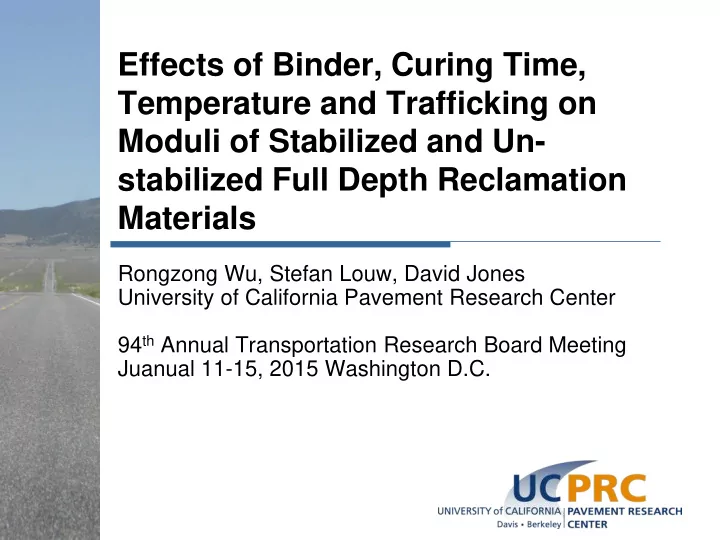

Effects of Binder, Curing Time, Temperature and Trafficking on Moduli of Stabilized and Un- stabilized Full Depth Reclamation Materials Rongzong Wu, Stefan Louw, David Jones University of California Pavement Research Center 94 th Annual Transportation Research Board Meeting Juanual 11-15, 2015 Washington D.C.
Outline Background Research Objective General Approach Data Collection Results and Discussion Summary and Conclusions
Background FDR = Full Depth Reclamation/Recycling Caltrans’ use of FDR Started since 2001 Mostly using combination of foam asphalt (FDR-FA) and cement (FDR-PC) as stabilizing agent Sometime no stabilization (FDR-NS) Growing interest for using engineering emulsion (FDR-EE)
Research Objective Revised guidelines and specification language for FDR in California Mechanistic-Empirical (M-E) design and performance parameters for FDR layers In-situ Stiffness Fatigue damage Rutting (permanent deformation under traffic)
What did others find about FDR stiffness? Quick and Guthrie (2011) FDR with emulsion Consistently low in the first 2 weeks Increase dramatically by 4 months Decrease considerably by 1 year Mohammad et al. (2003) FDR-FA layer More than doubled in the first month Syed and Scullion (2001) FDR-PC (i.e., cement) Higher cement% leads higher stiffness
General Approach (1/3) Work around the accelerated pavement testing (APT) study Test cells constructed for the APT Trafficking using heavy vehicle simulator (HVS) FWD at different occasions Right after construction Right before HVS trafficking Right after HVS trafficking
General Approach (2/3) FWD Testing Protocol Twice for each occasion: early morning and mid afternoon For testing around HVS: 4-m (before) + 8-m (within) + 4-m (after) 0.5 m interval HVS Test Section FWD Drop Locations 33 @ 0.5m interval
General Approach (3/3) Back-calculation Kalman-Filter based search algorithm Multilayer linear elastic system
Data Collection – The Test Cells 4 lanes at 3.7m wide each, each cell is 37 m long
Pavement Structure Layer: RHMA-G/RWMA-G Thickness: 60 mm (0.2 ft.) Layer: HMA Thickness: 60 mm (0.2 ft.) Layer: Imported Class 2 Aggregate Base Course Thickness: 450 mm (1.5 ft.) Layer: Prepared Subgrade Thickness: Semi-infinite Layer: HMA Thickness: 60 mm (0.2 ft.) or 120 mm (0.4 ft.) HMA Layer: Recycled Thickness: 250 mm (0.83 ft.) Layer: Imported Class 2 Aggregate Base Course Thickness: 320 mm (0.9 ft.) Layer: Prepared Subgrade Thickness: Semi-infinite
Data Collection - FWD Testing Schedule Days After FDR Material Occasion Construction After construction 19 FDR-NS (under 60mm Before Trafficking 57 HMA) After Trafficking 161 After construction 19 FDR-FA Before Trafficking 126 After Trafficking 240 After construction 19 FDR-PC Before Trafficking 239 After Trafficking 540 After construction 19 FDR-NS (under 120mm Before Trafficking 195 HMA) After Trafficking 314
Reaults and Discussion
Initial Stiffness @19 days
Initial Stiffness @ 19 days FDR-NS QQ-Plot for Normal Distribution of Natural Log 6.5 Quartiles of Natual Log of FDR-NS Moduli in MPa 6 5.5 5 4.5 4 -3 -2 -1 0 1 2 3 Standard Normal Quartiles
Initial Stiffness @ 19 days FDR-FA QQ-Plot for Normal Distribution 18000 16000 Quartiles of FDR-FA Moduli (MPa) 14000 12000 10000 8000 6000 4000 2000 0 -3 -2 -1 0 1 2 3 Standard Normal Quartiles
Initial Stiffness @ 19 days FDR-PC QQ-Plot for Normal Distribution 18000 16000 Quartiles of FDR-PC Moduli (MPa) 14000 12000 10000 8000 6000 4000 2000 0 -3 -2 -1 0 1 2 3 Standard Normal Quartiles
Initial Stiffness @ 19 days Average Standard Coefficient Material Approximate Mean Pavement Deviation of Type Distribution (MPa) Temperature (MPa) Variance 15 ° C FDR-NS Log-normal 220 117 0.53 20 ° C FDR-FA Normal 2,959 1,595 0.54 19 ° C FDR-PC Normal 8,925 2,978 0.33
Effect of Pavement Temperature
Effect of Curing Time
Effect of Trafficking + Curing ESALs When Average Residual Matreial C.O.V. Applied (MPa) Stiffnes Ratio (Mn) FDR-NS with Before 156 0.16 0 1.00 60 mm HMA After 137 0.19 5.1 0.88 FDR-NS with Before 186 0.17 0 1.00 120 mm HMA After 103 0.50 20.8 0.55 Before 5,100 0.23 0 1.00 FDR-FA After 1,490 0.19 17.0 0.29 Before 14,316 0.16 0 1.00 FDR-PC After 6,064 0.70 43.3 0.42
Effect of Trafficking Alone Ratio of (Trafficked) Relative Matreial When /(Non Trafficked) Ratio FDR-NS with Before HVS 1.09 60 mm HMA After HVS 1.18 1.08 Before HVS 1.09 FDR-NS with After HVS 0.47 0.43 120 mm HMA Long After HVS 0.73 0.67 Before 0.90 FDR-FA After 0.32 0.36 Before 0.90 FDR-PC After 0.35 0.39
Effect of Traffic Verification
Conclusions Initial stiffness @ 19 days FDR-NS: 200 MPa with c.o.v of 55% FDR-FA: 3000 MPa with c.o.v of 55% FDR-PC: 9000 MPa with c.o.v of 35% All FDR materials show slight sensitivity to temperature for their stiffness Effects of curing 50% increase for FDR-FA 80% increase for FDR-PC Roughtly unchanged for FDR-NS
Conclusions (continued) Effect of Trafficking About 60% drop in stiffness Likely caused by damage in the FDR layer FDR-NS shows re-stiffening after trafficking stopped, not sure whether is permanent Implication for design Need to account for damage in the FDR layer Curing is also critical.
QUESTIONS ?
Recommend
More recommend